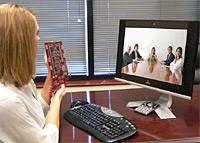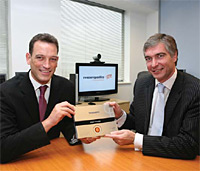
 |
Conferencing solutions are getting a lot of air play these days due not just to the trend for organisations to demonstrate their green credentials but also in the context of a more complete unified communications solution.
Audio conferencing provides a viable alternative to business travel, saving both time and money by significantly reducing unnecessary journeys. But just one in three UK companies currently use this type of ‘green friendly’ technology, according to recent research conducted by distributor Nimans - so there’s huge potential for dealers to exploit.
And the distributors should know as it is via this channel that the vendors shift the majority of their product. Nimans and fellow distributors Trust and Rocom seem set for a battle with each other for reseller business.
How are they supporting their resellers and what advice are they giving? How is it best to successfully integrate conferencing into a business portfolio and sell the concept to customers?
Nimans’ Sales Director Phil Adams says there are three main players in the UK - Polycom, Konftel and Clear One. Each offers a wide product range which is specifically designed for a host of different environments, from just a couple of users to potentially dozens in small meeting rooms or large boardrooms.
“We live in a very dynamic business world where collaborative decisions need to be quickly and efficiently made so that companies can be first to market with a particular product,” he said. “The difficulty with this is that the people involved in this process don’t necessarily all live and work in the same location. It could well be there’s a manufacturer in China, a design team in Rome, and another manufacturer in South America. The challenge is to get all those people together at one moment in time. What exists between all those decision makers is a common factor of distance. Audio conferencing allows you to eliminate distance between decision makers because it provides a quality of sound that is as if the people are in the room together. It’s like being there. ”
Conferencing opens up high margin opportunities for resellers according to Tom Maxwell, Head of Indirect Sales at Rocom. He says that it has always made a compelling case but it has taken time to translate that into action. Not any more – sales are rocketing and he thinks that they’ll accelerate even faster.
“The products now available deliver the reliability, ease of use and superb sound quality that create an environment in which genuine conferences with high speech quality can take place comfortably. Importantly, these products come in at price points that have mass market appeal.
“We partner with Polycom and the advances in its technology, performance and pricing mean that its products are no longer confined to the boardroom. They are essential aids to whole company efficiency. That’s underlined by our own sales increase – we’re up by well over 30pc this year.
“Sales are also being driven by environmental legislation. It won’t be long before companies will have to pay for their carbon footprint and anything that reduces it will deliver a massive ROI. It was interesting to see figures from conferencing VAR Questmark that calculated that its installed base saves about 26m travel miles each month. That’s a lot of carbon.
“Equally important is the hassle factor. Airports are no fun these days and Polycom has found that four out of five professionals feel that many face-to-face meetings are unnecessary and that the travel time wasted impacts severely on productivity.”
Maxwell urges resellers to take advantage of easily available training. “There is an opportunity for resellers to grow into the AV space simply by applying a new technology to their core business. As well as learning how to install into both the traditional and IP sectors, they will become increasingly alert to a great number of highmargin opportunities.”
Rocom concentrates on audio conferencing but Maxwell reveals that video conferencing is under review. “Video is reaching the same maturity as audio and we are studying the market closely.”
He’s convinced that if resellers take conferencing products seriously, they’ll add significant profitable revenues. “These are not box shifted peripherals – they’re serious business tools.”
Trust Distribution, just down the road from Nimans in Manchester has just secured a distribution deal with Konftel, the world’s second largest audio conference unit manufacturer, and formerly distributing in the UK exclusively through Nimans.
Trust say the Swedish company holds nearly 80% audio conference market share in the Nordic regions and represents a real dealer opportunity due to relatively low exposure in the UK.
Konftel claim to be technically advanced with superb performance; the range accommodates virtually any application, whether digital, IP or DECT PBX systems - or even connecting to PC or laptop for VoIP. Konftel’s was also the first range to include a Bluetooth unit.
Most dealers offer the leading audio conferencing brand, believed to be Polycom, but Trust is keen to highlight Konftel benefits to dealers. As Vincent Leahy, Joint Trust MD points out, “Offer Konftel in addition to the norm and you differentiate yourself from the crowd. Plus, with prices so low, why sell one leading brand unit when for just a few pounds more you can upsell to two equivalent Konftel units and double the benefit! This is no compromise – these really are top class units!”
Leahy seems delighted with Konftel prices, especially given their proven performance and reliability. “Konftel prices are incredibly low compared to the competition. For example, take the leading brand best-selling audio conference unit. The Konftel 200 is an admirable alternative, an excellent performer with double the warranty of its competitor. It includes external microphone expandability as standard and has a smaller footprint. Oh, and by the way, at £299.95 its retail price is 25% less than its equivalent! This is typical across the Konftel range!
Conferencing Context - Carbon Credit et al…
According to carbon trading firm, Climate Care, the average return flight from London to Washington DC produces 1.64 tonnes of CO2 per person.
It seems no one has a good word for business travel these days - and with good reason. Take the travellers themselves, for example. The 1,200 business travellers surveyed for the 2006 National Business Travel Monitor said that increasingly crowded aeroplanes, tightened security, flight delays and late-night work-related dinners were just some of the reasons why they would rather stay at home. Other downsides reported included sleep deprivation (47 per cent), increased stress (25 per cent) and loneliness (23 per cent). But you don’t have to fly to meet any more.
Built-in or Specialist Kit
Desktop audio conferencing products remain a good source of revenue for resellers and increasingly the communications platforms they are connected to have built-in conference bridges that lower user cost. This adds up to good value for users.
Martin Northend, Director of SME Portfolio Marketing at Siemens Enterprise Communications, on the latest developments:
“New desktop hardware should be designed with audio-conferencing in mind, and as such will incorporate the functionality of specialist ‘spider phone’ conference phones. Such hardware includes Siemens’ own recently-launched OpenStage desk phone, whose design keeps microphone and speaker apart in order to keep background noise to a minimum. In-built wideband codex optimises voice quality, while its acoustic chamber has also been optimised for maximum speaker performance.
“Specialist audio conferencing bridges or embedded conferencing servers in the switch itself are the next generation of audio conferencing. That said, although this emerging trend is for switch-embedded conferencing servers, this embedded approach is at the moment difficult to set up and difficult to use. But we can expect this to improve in the near future, with the introduction of easy-to-use ‘drag and drop’ user interfaces.
“The number of participants in the conference also influences whether one should use an “in-house” embedded conferencing system, or instead a specialist bridge service provided by a third party. The in-house option makes sense for an 8-10 person conference, as this number of callers won’t have an adverse effect upon your wider connectivity.
“For larger conferences, however - such as 12+ participants – the sheer volume of inbound traffic generated could clog up your switch and hinder additional, inbound caller traffic. That said, using an external conference service will incur additional service charges – usually a ‘pence-perminute’ cost for each participant, which would not be the case with an ‘in-house’ system.”
Northend also has an opinion on video applications as well and says there are two schools of thought to delivering this functionality: via the desktop PC with a connected camera, or via a camera-equipped desk phone.
“The PC certainly has the processing power to deal with such a data-heavy application like video, unlike a simple desk phone. However, it’s best to still use a separate dedicated handset for the voice element, since a PC is not designed to deliver optimised voice quality.
“Video is of course integral to a unified communications solution… however, as we have seen with audio conferencing, while it is easy to incorporate an audio bridge into a UC platform there is a still a trade-off between the number of external users versus conference quality. For a bandwidth-hungry application like video, the reality is that currently the best method of delivery is via a dedicated video server, which could in fact be provided by a third party service provider. “
Video Driving Margin Opportunity
Wayne Stephens, Director Partners and Alliances, EMEA, Tandberg says his company has recognised the opportunities that video offers both Service Providers and Systems Integrators and the value that can be delivered to customers by working together with these partners to provide a total communication and IT infrastructure which is managed globally with guaranteed service levels. Video drives significant new margin opportunities for Service Providers as video applications require bigger bandwidth, higher quality of service and now extend to the desktop. This is becoming more critical as customers are using visual communications more extensively to increase productivity, reduce costs and cut their carbon footprint.
HD Coming
 |
highest levels of quality and performance in a desktop solution to support any video collaboration application, including those that require the optimal HD video, voice and content clarity for natural communication and collaboration across distances.
The Polycom HDX 4000 solutions are complete, integrated video conferencing systems elegantly designed to fit on an executive desktop as a personal system, at a small table, or in a small conference room to support up to four people on camera. HDX 4000 systems contain all necessary components including an integrated 20-inch 16:9 display that can double as a PC monitor; a built-in HD camera with pan-tilt-zoom capability; integrated dual HDX microphones, high-fidelity speakers and subwoofers; a powerful, standards-based HDX video conferencing codec; and a stand with an integrated keypad that allows users to dial or answer video calls just like a telephone.
Applications for the system include enhanced communication and collaboration among co workers, partners, and customers, as well as a broad range of business applications that rely on small but critical details for a variety of industries, including merger and acquisition negotiations, outsource management, manufacturing processes, hiring procedures, customer and partner negotiations, and research and development design activities.
The ability to simultaneously share content in high definition, such as architectural or CAD drawings, animation, movies, or images from HD document cameras such as detailed circuit boards, intricate fabrics, patient X-rays, etc., creates new opportunities to streamline and accelerate business processes in fields such as medicine and healthcare, education, manufacturing, film making, fashion and design, advertising and more.
To assist customers deploying HD video conferencing, Polycom is putting together a suite of HD Readiness services through its channel partners - from planning and design to evaluating and optimising HD video performance on existing networks to standard maintenance and service options.
Reseller Comment – Margolis
 |
Reseller Comment - Questmark
Reseller Questmark has interpreted the recent Wainhouse research in to the use of video conferencing, which indicates that room based systems deployed in the pharmaceutical sector are only used for around two hours a month, as an indictment of poor channel performance.
Chief Executive Sam McMaster claims that this level of utilisation is worrying as driving usage is crucial to establishing videoconferencing as an accepted and cost-effective business tool.
“How can we hope to grow the industry,” he asks, “if the norm for usage in a sector that is seen as a leading user of the technology is so low?”
From the survey’s figures system use is on average less than 1% of the available time. Despite this in many cases a system that is used so little will still provide a return on investment for the buyer showing that the business case for deploying meeting room videoconferencing is so strong; yet the industry is still so immature and relatively minute compared to other areas of the ICT spectrum.
“There are a number of reasons for this situation,” Sam continues. “From long experience I know that one of the critical factors for this poor usage has been the channel policies of the manufacturers that result in poor quality resellers doing a pretty awful job for the end-user.
“Too many resellers don’t realise that their job is not just to deliver and set up the systems and connect them to the network, but to work with their customers to integrate this technology into their business operations. This makes it easy to create an internal demand for access to videoconferencing to the point where they wonder how they ever got by without it.”
McMaster sees this short-sighted, boxshifting mentality afflicting manufacturers just as much, driven, as they are, by the need to achieve their quarterly sales figures rather than by a jobwell- done approach.
